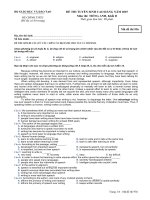Tài liệu - Khởi Nghiệp Tinh Gọn (Tiếng Anh)
Bạn đang xem bản rút gọn của tài liệu. Xem và tải ngay bản đầy đủ của tài liệu tại đây (2.56 MB, 248 trang )
eBook miễn phí tại: Webtietkiem.com
Page 1
Acclaim for THE LEAN STARTUP
eBook miễn phí tại: Webtietkiem.com
―The Lean Startup isn‘t just about how to create a more successful entrepreneurial business;
it‘s about what we can learn from those businesses to improve virtually everything we do. I
imagine Lean Startup principles applied to government programs, to health care, and to
solving the world‘s great problems. It‘s ultimately an answer to the question How can we learn
more quickly what works and discard what doesn‘t?‖
—Tim O’Reilly, CEO, O’Reilly Media
―Eric Ries unravels the mysteries of entrepreneurship and reveals that magic and genius are
not the necessary ingredients for success but instead proposes a scientific process that can
be learned and replicated. Whether you are a startup entrepreneur or corporate entrepreneur,
there are important lessons here for you on your quest toward the new and unknown.‖
—Tim Brown, CEO, IDEO
―The road map for innovation for the twenty-first century. The ideas in The Lean Startup will
help create the next industrial revolution.‖
—Steve Blank, lecturer, Stanford University, UC
Berkeley Hass Business School
―Every founding team should stop for forty-eight hours and read The Lean Startup. Seriously,
stop and read this book now.‖
—Scott Case, CEO, Startup America Partnership
―The key lesson of this book is that startups happen in the present—that messy place
between the past and the future where nothing happens according to PowerPoint. Ries‘s
‗read and react‘ approach to this sport, his relentless focus on validated learning, the neverending anxiety of hovering between ‗persevere‘ and ‗pivot,‘ all bear witness to his
appreciation for the
eBook miễn phí tại: Webtietkiem.com
Page 2
dynamics of entrepreneurship.‖
—Geoffrey Moore, author, Crossing the Chasm
―If you are an entrepreneur, read this book. If you are thinking about becoming an
entrepreneur, read this book. If you are just curious about entrepreneurship, read this book.
Starting Lean is today‘s best practice for innovators. Do yourself a favor and read this book.‖
—Randy Komisar, founding director of TiVo and author of the bestselling
The Monk and the Riddle
―How do you apply the fifty-year-old ideas of Lean to the fast-paced, high-uncertainty world of
startups? This book provides a brilliant, well-documented, and practical answer. It is sure to
become a management classic.‖
—Don Reinertsen, author, The Principles of Product Development Flow
―What would happen if businesses were built from the ground up to learn what their
customers really wanted? The Lean Startup is the foundation for reimagining almost
everything about how work works. Don‘t let the word startup in the title confuse you. This is a
cookbook for entrepreneurs in organizations of all sizes.‖
—Roy Bahat, president, IGN Entertainment
―The Lean Startup is a foundational must-read for founders, enabling them to reduce product
failures by bringing structure and science to what is usually informal and an art. It provides
actionable ways to avoid product-learning mistakes, rigorously evaluate early signals from the
market through validated learning, and decide whether to persevere or to pivot, all challenges
that heighten the chance of entrepreneurial failure.‖
—Noam Wasserman, professor, Harvard Business School
―One of the best and most insightful new books on entrepreneurship and management I‘ve
ever read. Should be required reading not only for the entrepreneurs that I work with, but for
my friends and colleagues in various industries who have inevitably grappled with many of the
challenges that The Lean Startup addresses.‖
—Eugene J. Huang, partner, True North Venture Partner
eBook miễn phí tại: Webtietkiem.com
Page 3
―In business, a ‗lean‘ enterprise is sustainable efficiency in action. Eric Ries‘s revolutionary
Lean Startup method will help bring your new business idea to an end result that is successful
and sustainable. You‘ll find innovative steps and strategies for creating and managing your
own startup while learning from the real-life successes and collapses of others. This book is a
must-read for entrepreneurs who are truly ready to start something great!‖
—Ken Blanchard, coauthor of The One Minute Manager® and The
One Minute Entrepreneur
eBook miễn phí tại: Webtietkiem.com
Page 4
eBook miễn phí tại: Webtietkiem.com
Page 5
Copyright © 2011 by Eric Ries
All rights reserved.
Published in the United States by Crown Business, an imprint of the Crown Publishing Group, a division of Random House, Inc., New York.
www.crownpublishing.com
CROWN BUSINESS is a trademark and CROWN and the Rising Sun colophon are registered trademarks of Random House, Inc.
Library of Congress Cataloging-in-Publication Data
Ries, Eric, 1978–
The lean startup / Eric Ries. — 1st ed.
p. cm.
1. New business enterprises. 2. Consumers‘ preferences. 3. Organizational effectiveness. I. Title. HD62.5.R545 2011
658.1′1—dc22 2011012100
eISBN: 978-0-307-88791-7
Book design by Lauren Dong
Illustrations by Fred Haynes
Jacket design by Marcus Gosling
v3.1
eBook miễn phí tại: Webtietkiem.com
Page 6
Contents
Cover
Title Page
Copyright
Dedication
Introduction
Part One VISION
1.
2.
3.
4.
Start
Define
Learn
Experiment
Part Two STEER
5.
6.
7.
8.
Leap
Test
Measure
Pivot (or Persevere)
Part Three ACCELERATE
9.
10.
11.
12.
13.
14.
Batch
Grow
Adapt
Innovate
Epilogue: Waste Not
Join the Movement
Endnotes
Disclosures
Acknowledgments
About the Author
eBook miễn phí tại: Webtietkiem.com
Page 7
Introduction
S
top me if you‘ve heard
this one before. Brilliant college kids sitting in a dorm are
inventing the future. Heedless of boundaries, possessed of new technology and youthful
enthusiasm, they build a new company from scratch. Their early success allows them to raise money
and bring an amazing new product to market. They hire their friends, assemble a superstar team,
and
dare the world to stop them.
Ten years and several startups ago, that was me, building my first company. I particularly
remember a moment from back then: the moment I realized my company was going to fail.
My cofounder and I were at our wits‘ end. The dot-com bubble had burst, and we had spent
all our money. We tried desperately to raise more capital, and we could not. It was like a
breakup scene from a Hollywood movie: it was raining, and we were arguing in the street. We
couldn‘t even agree on where to walk next, and so we parted in anger, heading in opposite
directions. As a metaphor for our company‘s failure, this image of the two of us, lost in the
rain and drifting apart, is perfect.
It remains a painful memory. The company limped along for months afterward, but our
situation was hopeless. At the time, it had seemed we were doing everything right: we had a
great product, a brilliant team, amazing technology, and the right idea at the right time. And
we really were on to something. We were building a way for college kids to create online
profiles for the purpose of sharing … with employers. Oops. But despite a promising idea, we
were nonetheless doomed from day one, because we did not know the process we would
need to use to turn our product insights into a great company.
If you‘ve never experienced a failure like this, it is hard to describe the feeling. It‘s as if the
world were falling out from under you. You realize you‘ve been duped. The stories in the
magazines are lies: hard work and perseverance don‘t lead to success. Even worse, the
many, many, many promises you‘ve made to employees, friends, and family are not going to
eBook miễn phí tại: Webtietkiem.com
Page 8
come true. Everyone who thought you were foolish for stepping out on your own will be
proven right.
It wasn‘t supposed to turn out that way. In magazines and newspapers, in blockbuster
movies, and on countless blogs, we hear the mantra of the successful entrepreneurs: through
determination, brilliance, great timing, and —above all—a great product, you too can achieve
fame and fortune.
There is a mythmaking industry hard at work to sell us that story, but I have come to
believe that the story is false, the product of selection bias and after-the-fact rationalization. In
fact, having worked with hundreds of entrepreneurs, I have seen firsthand how often a
promising start leads to failure. The grim reality is that most startups fail. Most new products
are not successful. Most new ventures do not live up to their potential.
Yet the story of perseverance, creative genius, and hard work persists. Why is it so
popular? I think there is something deeply appealing about this modern-day rags-to-riches
story. It makes success seem inevitable if you just have the right stuff. It means that the
mundane details, the boring stuff, the small individual choices don‘t matter. If we build it, they
will come. When we fail, as so many of us do, we have a ready-made excuse: we didn‘t have
the right stuff. We weren‘t visionary enough or weren‘t in the right place at the right time.
After more than ten years as an entrepreneur, I came to reject that line of thinking. I have
learned from both my own successes and failures and those of many others that it‘s the
boring stuff that matters the most. Startup success is not a consequence of good genes or
being in the right place at the right time. Startup success can be engineered by following the
right process, which means it can be learned, which means it can be taught.
Entrepreneurship is a kind of management. No, you didn‘t read that wrong. We have wildly
divergent associations with these two words, entrepreneurship and management. Lately, it
seems that one is cool, innovative, and exciting and the other is dull, serious, and bland. It is
time to look past these preconceptions.
Let me tell you a second startup story. It‘s 2004, and a group of founders have just started
a new company. Their previous company had failed very publicly. Their credibility is at an alltime low. They have a huge vision: to change the way people communicate by using a new
technology called avatars (remember, this was before James Cameron‘s blockbuster movie).
They are following a visionary named Will Harvey, who paints a compelling picture: people
connecting with their friends, hanging out online, using
eBook miễn phí tại: Webtietkiem.com
Page 9
avatars to give them a combination of intimate connection and safe anonymity. Even better,
instead of having to build all the clothing, furniture, and accessories these avatars would need
to accessorize their digital lives, the customers would be enlisted to build those things and
sell them to one another.
The engineering challenge before them is immense: creating virtual worlds, user generated content, an online commerce engine, micropayments, and— last but not least—the
three-dimensional avatar technology that can run on anyone‘s PC.
I‘m in this second story, too. I‘m a cofounder and chief technology officer of this company,
which is called IMVU. At this point in our careers, my cofounders and I are determined to
make new mistakes. We do everything wrong: instead of spending years perfecting our
technology, we build a minimum viable product, an early product that is terrible, full of bugs
and crash-your -computer-yes-really stability problems. Then we ship it to customers way
before it‘s ready. And we charge money for it. After securing initial customers, we change the
product constantly—much too fast by traditional standards—shipping new versions of our
product dozens of times every single day.
We really did have customers in those early days—true visionary early adopters—and we
often talked to them and asked for their feedback. But we emphatically did not do what they
said. We viewed their input as only one source of information about our product and overall
vision. In fact, we were much more likely to run experiments on our customers than we were
to cater to their whims.
Traditional business thinking says that this approach shouldn‘t work, but it does, and you
don‘t have to take my word for it. As you‘ll see throughout this book, the approach we
pioneered at IMVU has become the basis for a new movement of entrepreneurs around the
world. It builds on many previous management and product development ideas, including
lean manufacturing, design thinking, customer development, and agile development. It
represents a new approach to creating continuous innovation. It‘s called the Lean Startup.
Despite the volumes written on business strategy, the key attributes of business leaders,
and ways to identify the next big thing, innovators still struggle to bring their ideas to life. This
was the frustration that led us to try a radical new approach at IMVU, one characterized by an
extremely fast cycle time, a focus on what customers want (without asking them), and a
eBook miễn phí tại: Webtietkiem.com
Page 10
scientific approach to making decisions.
ORIGINS OF THE LEAN STARTUP
I am one of those people who grew up programming computers, and so my journey to
thinking about entrepreneurship and management has taken a circuitous path. I have always
worked on the product development side of my industry; my partners and bosses were
managers or marketers, and my peers worked in engineering and operations. Throughout my
career, I kept having the experience of working incredibly hard on products that ultimately
failed in the marketplace.
At first, largely because of my background, I viewed these as technical problems that
required technical solutions: better architecture, a better engineering process, better
discipline, focus, or product vision. These supposed fixes led to still more failure. So I read
everything I could get my hands on and was blessed to have had some of the top minds in
Silicon Valley as my mentors. By the time I became a cofounder of IMVU, I was hungry for
new ideas about how to build a company.
I was fortunate to have cofounders who were willing to experiment with new approaches.
They were fed up—as I was—by the failure of traditional thinking. Also, we were lucky to have
Steve Blank as an investor and adviser. Back in 2004, Steve had just begun preaching a new
idea: the business and marketing functions of a startup should be considered as important as
engineering and product development and therefore deserve an equally rigorous
methodology to guide them. He called that methodology Customer Development, and it
offered insight and guidance to my daily work as an entrepreneur.
Meanwhile, I was building IMVU‘s product development team, using some of the
unorthodox methods I mentioned earlier. Measured against the traditional theories of product
development I had been trained on in my career, these methods did not make sense, yet I
could see firsthand that they were working. I struggled to explain the practices to new
employees, investors, and the founders of other companies. We lacked a common language
for describing them and concrete principles for understanding them.
I began to search outside entrepreneurship for ideas that could help me make sense of my
experience. I began to study other industries, especially manufacturing, from which most
modern theories of management derive. I
eBook miễn phí tại: Webtietkiem.com
Page 11
studied lean manufacturing, a process that originated in Japan with the Toyota Production
System, a completely new way of thinking about the manufacturing of physical goods. I found
that by applying ideas from lean manufacturing to my own entrepreneurial challenges—with a
few tweaks and changes—I had the beginnings of a framework for making sense of them.
This line of thought evolved into the Lean Startup: the application of lean thinking to the
process of innovation.
IMVU became a tremendous success. IMVU customers have created more than 60 million
avatars. It is a profitable company with annual revenues of more than $50 million in 2011,
employing more than a hundred people in our current offices in Mountain View, California.
IMVU‘s virtual goods catalog—which seemed so risky years ago—now has more than 6
million items in it; more than 7,000 are added every day, almost all created by customers.
As a result of IMVU‘s success, I began to be asked for advice by other startups and
venture capitalists. When I would describe my experiences at IMVU, I was often met with
blank stares or extreme skepticism. The most common reply was ―That could never work!‖ My
experience so flew in the face of conventional thinking that most people, even in the
innovation hub of Silicon Valley, could not wrap their minds around it.
Then I started to write, first on a blog called Startup Lessons Learned, and speak—at
conferences and to companies, startups, and venture capitalists—to anyone who would
listen. In the process of being called on to defend and explain my insights and with the
collaboration of other writers, thinkers, and entrepreneurs, I had a chance to refine and
develop the theory of the Lean Startup beyond its rudimentary beginnings. My hope all along
was to find ways to eliminate the tremendous waste I saw all around me: startups that built
products nobody wanted, new products pulled from the shelves, countless dreams
unrealized.
Eventually, the Lean Startup idea blossomed into a global movement. Entrepreneurs
began forming local in-person groups to discuss and apply Lean Startup ideas. There are
now organized communities of practice in more than a hundred cities around the world.1 My
travels have taken me across countries and continents. Everywhere I have seen the signs of
a new entrepreneurial renaissance. The Lean Startup movement is making entrepreneurship
accessible to a whole new generation of founders who are hungry for new ideas about how to
build successful companies.
Although my background is in high-tech software entrepreneurship, the
eBook miễn phí tại: Webtietkiem.com
Page 12
movement has grown way beyond those roots. Thousands of entrepreneurs are putting Lean
Startup principles to work in every conceivable industry. I‘ve had the chance to work with
entrepreneurs in companies of all sizes, in different industries, and even in government. This
journey has taken me to places I never imagined I‘d see, from the world‘s most elite venture
capitalists, to Fortune 500 boardrooms, to the Pentagon. The most nervous I have ever been
in a meeting was when I was attempting to explain Lean Startup principles to the chief
information officer of the U.S. Army, who is a three-star general (for the record, he was
extremely open to new ideas, even from a civilian like me).
Pretty soon I realized that it was time to focus on the Lean Startup movement full time. My
mission: to improve the success rate of new innovative products worldwide. The result is the
book you are reading.
THE LEAN STARTUP METHOD
This is a book for entrepreneurs and the people who hold them accountable. The five
principles of the Lean Startup, which inform all three parts of this book, are as follows:
1. Entrepreneurs are everywhere. You don‘t have to work in a garage to be in a startup.
The concept of entrepreneurship includes anyone who works within my definition of a startup:
a human institution designed to create new products and services under conditions of
extreme uncertainty. That means entrepreneurs are everywhere and the Lean Startup
approach can work in any size company, even a very large enterprise, in any sector or
industry.
2. Entrepreneurship is management. A startup is an institution, not just a product, and
so it requires a new kind of management specifically geared to its context of extreme
uncertainty. In fact, as I will argue later, I believe ―entrepreneur‖ should be considered a job
title in all modern companies that depend on innovation for their future growth.
3. Validated learning. Startups exist not just to make stuff, make money, or even serve
customers. They exist to learn how to build a sustainable
eBook miễn phí tại: Webtietkiem.com
Page 13
business. This learning can be validated scientifically by running frequent experiments that
allow entrepreneurs to test each element of their vision.
4. Build-Measure-Learn. The fundamental activity of a startup is to turn ideas into
products, measure how customers respond, and then learn whether to pivot or persevere. All
successful startup processes should be geared to accelerate that feedback loop.
5. Innovation accounting. To improve entrepreneurial outcomes and hold innovators
accountable, we need to focus on the boring stuff: how to measure progress, how to set up
milestones, and how to prioritize work. This requires a new kind of accounting designed for
startups—and the people who hold them accountable.
Why Startups Fail
Why are startups failing so badly everywhere we look?
The first problem is the allure of a good plan, a solid strategy, and thorough market
research. In earlier eras, these things were indicators of likely success. The overwhelming
temptation is to apply them to startups too, but this doesn‘t work, because startups operate
with too much uncertainty. Startups do not yet know who their customer is or what their
product should be. As the world becomes more uncertain, it gets harder and harder to predict
the future. The old management methods are not up to the task. Planning and forecasting are
only accurate when based on a long, stable operating history and a relatively static
environment. Startups have neither.
The second problem is that after seeing traditional management fail to solve this problem,
some entrepreneurs and investors have thrown up their hands and adopted the ―Just Do It‖
school of startups. This school believes that if management is the problem, chaos is the
answer. Unfortunately, as I can attest firsthand, this doesn‘t work either.
It may seem counterintuitive to think that something as disruptive, innovative, and chaotic
as a startup can be managed or, to be accurate, must be managed. Most people think of
process and management as boring and dull, whereas startups are dynamic and exciting. But
what is actually exciting is to see startups succeed and change the world. The passion,
energy, and
eBook miễn phí tại: Webtietkiem.com
Page 14
vision that people bring to these new ventures are resources too precious to waste. We can—
and must—do better. This book is about how.
eBook miễn phí tại: Webtietkiem.com
Page 15
HOW THIS BOOK IS ORGANIZED
This book is divided into three parts: ―Vision,‖ ―Steer,‖ and ―Accelerate.‖ ―Vision‖ makes the
case for a new discipline of entrepreneurial
management. I identify who is an entrepreneur, define a startup, and articulate a new way for
startups to gauge if they are making progress, called validated learning. To achieve that
learning, we‘ll see that startups—in a garage or inside an enterprise—can use scientific
experimentation to discover how to build a sustainable business.
―Steer‖ dives into the Lean Startup method in detail, showing one major turn through the
core Build-Measure-Learn feedback loop. Beginning with leap-of-faith assumptions that cry
out for rigorous testing, you‘ll learn how to build a minimum viable product to test those
assumptions, a new accounting system for evaluating whether you‘re making progress, and a
method for deciding whether to pivot (changing course with one foot anchored to the ground)
or persevere.
In ―Accelerate,‖ we‘ll explore techniques that enable Lean Startups to speed through the
Build-Measure-Learn feedback loop as quickly as possible, even as they scale. We‘ll explore
lean manufacturing concepts that are applicable to startups, too, such as the power of small
batches. We‘ll also discuss organizational design, how products grow, and how to apply Lean
Startup principles beyond the proverbial garage, even inside the world‘s largest companies.
MANAGEMENT’S SECOND CENTURY
As a society, we have a proven set of techniques for managing big companies and we know
the best practices for building physical products. But when it comes to startups and
innovation, we are still shooting in the dark. We are relying on vision, chasing the ―great men‖
who can make magic happen, or trying to analyze our new products to death. These are new
problems, born of the success of management in the twentieth century.
This book attempts to put entrepreneurship and innovation on a rigorous footing. We are at
the dawn of management‘s second century. It is our challenge to do something great with the
opportunity we have been given. The Lean Startup movement seeks to ensure that those of
us who long to
eBook miễn phí tại: Webtietkiem.com
Page 16
build the next big thing will have the tools we need to change the world.
eBook miễn phí tại: Webtietkiem.com
Page 17
Part One
VISION
eBook miễn phí tại: Webtietkiem.com
Page 18
1
START
ENTREPRENEURIAL MANAGEMENT
B
uilding a startup is an
exercise in institution building; thus, it necessarily involves
management. This often comes as a surprise to aspiring entrepreneurs, because their associations
with these two words are so diametrically opposed. Entrepreneurs are rightly wary of
implementing traditional management practices early on in a startup, afraid that they will
invite bureaucracy or stifle creativity.
Entrepreneurs have been trying to fit the square peg of their unique problems into the
round hole of general management for decades. As a result, many entrepreneurs take a ―just
do it‖ attitude, avoiding all forms of management, process, and discipline. Unfortunately, this
approach leads to chaos more often than it does to success. I should know: my first startup
failures were all of this kind.
The tremendous success of general management over the last century has provided
unprecedented material abundance, but those management principles are ill suited to handle
the chaos and uncertainty that startups must face.
I believe that entrepreneurship requires a managerial discipline to harness the entrepreneurial
opportunity we have been given.
There are more entrepreneurs operating today than at any previous time in history. This
has been made possible by dramatic changes in the global economy. To cite but one
example, one often hears commentators lament the loss of manufacturing jobs in the United
States over the previous two decades, but one rarely hears about a corresponding loss of
manufacturing capability. That‘s because total manufacturing output in the United States is
increasing (by 15 percent in the last decade) even as jobs continue to be lost
eBook miễn phí tại: Webtietkiem.com
Page 19
(see the charts below). In effect, the huge productivity increases made possible by modern
management and technology have created more productive capacity than firms know what to
do with.1
We are living through an unprecedented worldwide entrepreneurial renaissance, but this
opportunity is laced with peril. Because we lack a coherent management paradigm for new
innovative ventures, we‘re throwing our excess capacity around with wild abandon. Despite
this lack of rigor, we are finding some ways to make money, but for every success there are
far too many failures: products pulled from shelves mere weeks after being launched, highprofile startups lauded in the press and forgotten a few months later, and new products that
wind up being used by nobody. What makes these failures particularly painful is not just the
economic damage done to individual employees, companies, and investors; they are also a
colossal waste of our civilization‘s most precious resource: the time, passion, and skill of its
people. The Lean Startup movement is dedicated to preventing these failures.
eBook miễn phí tại: Webtietkiem.com
Page 20
THE ROOTS OF THE LEAN STARTUP
The Lean Startup takes its name from the lean manufacturing revolution that Taiichi Ohno
and Shigeo Shingo are credited with developing at Toyota. Lean thinking is radically altering
the way supply chains and production systems are run. Among its tenets are drawing on the
eBook miễn phí tại: Webtietkiem.com
Page 21
knowledge and creativity of individual workers, the shrinking of batch sizes, just-in-time
production and
eBook miễn phí tại: Webtietkiem.com
Page 22
inventory control, and an acceleration of cycle times. It taught the world the difference
between value-creating activities and waste and showed how to build quality into products
from the inside out.
The Lean Startup adapts these ideas to the context of entrepreneurship, proposing that
entrepreneurs judge their progress differently from the way other kinds of ventures do.
Progress in manufacturing is measured by the production of high-quality physical goods. As
we‘ll see in Chapter 3, the Lean Startup uses a different unit of progress, called validated
learning. With scientific learning as our yardstick, we can discover and eliminate the sources
of waste that are plaguing entrepreneurship.
A comprehensive theory of entrepreneurship should address all the functions of an earlystage venture: vision and concept, product development, marketing and sales, scaling up,
partnerships and distribution, and structure and organizational design. It has to provide a
method for measuring progress in the context of extreme uncertainty. It can give
entrepreneurs clear guidance on how to make the many trade-off decisions they face:
whether and when to invest in process; formulating, planning, and creating infrastructure;
when to go it alone and when to partner; when to respond to feedback and when to stick with
vision; and how and when to invest in scaling the business. Most of all, it must allow
entrepreneurs to make testable predictions.
For example, consider the recommendation that you build cross-functional teams and hold
them accountable to what we call learning milestones instead of organizing your company
into strict functional departments (marketing, sales, information technology, human resources,
etc.) that hold people accountable for performing well in their specialized areas (see Chapter
7). Perhaps you agree with this recommendation, or perhaps you are skeptical. Either way, if
you decide to implement it, I predict that you pretty quickly will get feedback from your teams
that the new process is reducing their productivity. They will ask to go back to the old way of
working, in which they had the opportunity to ―stay efficient‖ by working in larger batches and
passing work between departments.
It‘s safe to predict this result, and not just because I have seen it many times in the
companies I work with. It is a straightforward prediction of the Lean Startup theory itself.
When people are used to evaluating their productivity locally, they feel that a good day is one
in which they did their job well all day. When I worked as a programmer, that meant eight
straight hours of programming without interruption. That was a good day. In
eBook miễn phí tại: Webtietkiem.com
Page 23
contrast, if I was interrupted with questions, process, or—heaven forbid— meetings, I felt bad.
What did I really accomplish that day? Code and product features were tangible to me; I could
see them, understand them, and show them off. Learning, by contrast, is frustratingly
intangible.
The Lean Startup asks people to start measuring their productivity differently. Because
startups often accidentally build something nobody wants, it doesn‘t matter much if they do it
on time and on budget. The goal of a startup is to figure out the right thing to build—the thing
customers want and will pay for—as quickly as possible. In other words, the Lean Startup is a
new way of looking at the development of innovative new products that emphasizes fast
iteration and customer insight, a huge vision, and great ambition, all at the same time.
Henry Ford is one of the most successful and celebrated entrepreneurs of all time. Since the
idea of management has been bound up with the history of the automobile since its first days,
I believe it is fitting to use the automobile as a metaphor for a startup.
An internal combustion automobile is powered by two important and very different
feedback loops. The first feedback loop is deep inside the engine. Before Henry Ford was a
famous CEO, he was an engineer. He spent his days and nights tinkering in his garage with
the precise mechanics of getting the engine cylinders to move. Each tiny explosion within the
cylinder provides the motive force to turn the wheels but also drives the ignition of the next
explosion. Unless the timing of this feedback loop is managed precisely, the engine will
sputter and break down.
Startups have a similar engine that I call the engine of growth. The markets and customers
for startups are diverse: a toy company, a consulting firm, and a manufacturing plant may not
seem like they have much in common, but, as we‘ll see, they operate with the same engine of
growth.
Every new version of a product, every new feature, and every new marketing program is
an attempt to improve this engine of growth. Like Henry Ford‘s tinkering in his garage, not all
of these changes turn out to be improvements. New product development happens in fits and
starts. Much of the time in a startup‘s life is spent tuning the engine by making improvements
in product, marketing, or operations.
The second important feedback loop in an automobile is between the driver and the
steering wheel. This feedback is so immediate and automatic
eBook miễn phí tại: Webtietkiem.com
Page 24
that we often don‘t think about it, but it is steering that differentiates driving from most other
forms of transportation. If you have a daily commute, you probably know the route so well that
your hands seem to steer you there on their own accord. We can practically drive the route in
our sleep. Yet if I asked you to close your eyes and write down exactly how to get to your
office—not the street directions but every action you need to take, every push of hand on
wheel and foot on pedals—you‘d find it impossible. The choreography of driving is incredibly
complex when one slows down to think about it.
By contrast, a rocket ship requires just this kind of in-advance calibration. It must be
launched with the most precise instructions on what to do: every thrust, every firing of a
booster, and every change in direction. The tiniest error at the point of launch could yield
catastrophic results thousands of miles later.
Unfortunately, too many startup business plans look more like they are planning to launch
a rocket ship than drive a car. They prescribe the steps to take and the results to expect in
excruciating detail, and as in planning to launch a rocket, they are set up in such a way that
even tiny errors in assumptions can lead to catastrophic outcomes.
One company I worked with had the misfortune of forecasting significant customer
adoption—in the millions—for one of its new products. Powered by a splashy launch, the
company successfully executed its plan. Unfortunately, customers did not flock to the product
in great numbers. Even worse, the company had invested in massive infrastructure, hiring,
and support to handle the influx of customers it expected. When the customers failed to
materialize, the company had committed itself so completely that they could not adapt in time.
They had ―achieved failure‖—successfully, faithfully, and rigorously executing a plan that
turned out to have been utterly flawed.
The Lean Startup method, in contrast, is designed to teach you how to drive a startup.
Instead of making complex plans that are based on a lot of assumptions, you can make
constant adjustments with a steering wheel called the Build-Measure -Learn feedback loop.
Through this process of steering, we can learn when and if it‘s time to make a sharp turn
called a pivot or whether we should persevere along our current path. Once we have an
engine that‘s revved up, the Lean Startup offers methods to scale and grow the business with
maximum acceleration.
Throughout the process of driving, you always have a clear idea of where you‘re going. If
you‘re commuting to work, you don‘t give up because there‘s
eBook miễn phí tại: Webtietkiem.com
Page 25









